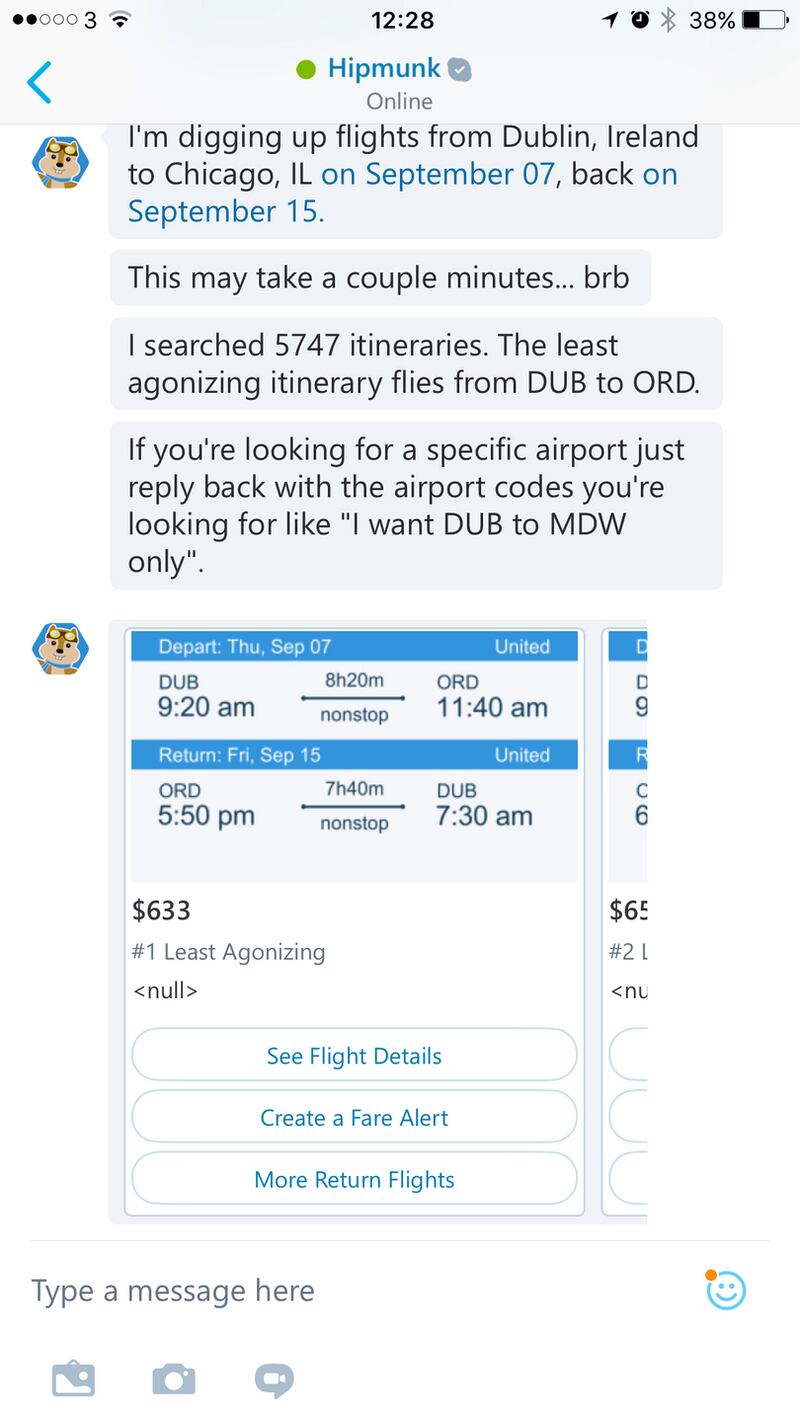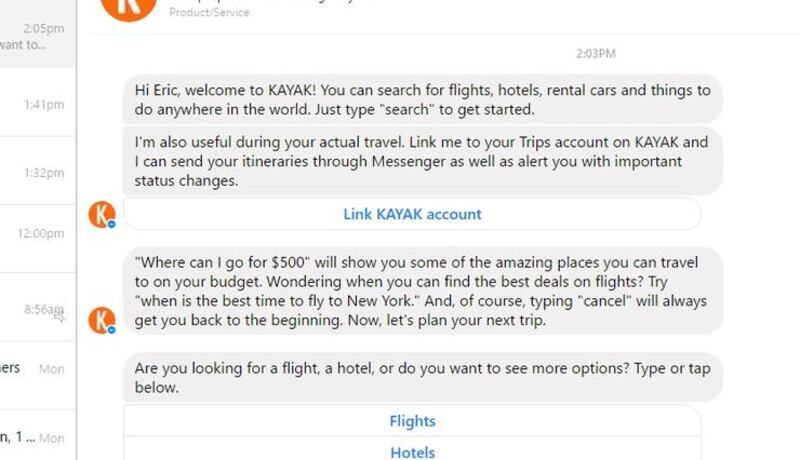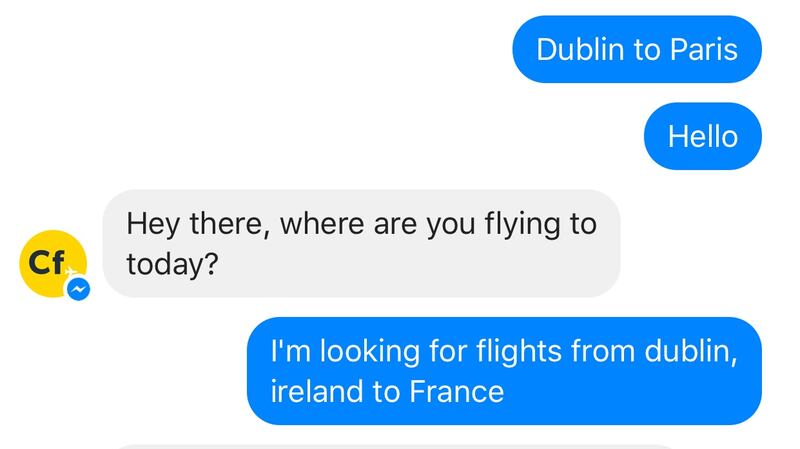When was the last time you visited a bricks-and-mortar travel agent? These days we rely rely on thousands of online travel sites, from airline and hotel websites and apps to aggregator websites and travel metasearch engines such as Expedia, LastMinute, Kayak and Skyscanner.
Service with a smile has been replaced by a largely impersonal travel booking experience where we search, hem and haw, search again, further hem and haw and finally press the “Pay now” button while worrying that we didn’t get the best price after all.
And lately it has been getting all the more exciting, because thanks to artificial intelligence, we can have an actual conversation as we book anything from a simple European flight to a multi-leg trip across the world. Not a conversation with a real person, obviously. A conversation with a chatbot.
First things first: what is a chatbot? In short, it is a nonhuman computer generated chatting experience with human-like conversation and natural language abilities. Simple. This means a chatbot can mimic human conversation within limitations that are increasingly being expanded due to the power of cloud-based data analytics. Chatbots operate in near real-time so a user can easily be lulled into feeling that they are talking to another real person.
AI advances
Advances in artificial intelligence have allowed companies such as Facebook, Google, Apple and Amazon offer these conversational routes for customers to order products or interact with the company through messaging or speech software.
Travel companies were quick to join with the likes of Expedia, Booking. com, Skyscanner and Cheapflights integrating chatbots with Facebook Messenger, Skype and Alexa, Amazon's intelligent personal assistant. In the airline space KLM was leading the way but Icelandair and others are quickly catching up.
For travel planning and booking company Kayak, which processed 1.5 billion searches in 2016, using chatbots is a way to bring their services to platforms where users are already spending most of their time.
"So far we've focused on Facebook Messenger, Amazon Alexa (voice), Slack and, most recently, Google Home," says Matthias Keller of Kayak. "We want to help users plan, book and manage their travel without . . . needing to switch to another website or install an app."

So why are travel companies moving towards messaging platforms as opposed to branded apps? The word on the techie street is that the world of the conventional app is on the way out. Although the app marketplace is estimated to range from $77 billion to $150 billion for 2017, app usage is projected to plateau.
Based on a Nielsen study in 2015, the number of apps the average smartphone owner regularly accessed remained relatively constant – at 26 – over the previous two years despite the number of apps on offer climbing. For American users, this dropped to 21 in 2016, according to data digital researcher eMarketer. Research from AppsFlyer found that after a 30-day period only 3.2 per cent of iOS apps and 3.3 per cent of Android apps were still actively used.
Getting the message
The apps that work are messaging apps. According eMarketer, last year 1.6 billion people were using mobile phone messaging apps, and it expects this to reach two billion by next year. This means more than 70 per cent of all smartphone users use a messaging app, whether WhatsApp, Facebook Messenger, Viber or WeChat. Back in 2014 Facebook Messenger became a platform in itself, when the company forced users to download the standalone Messenger app to keep chatting with friends. It mirrored an earlier move by WeChat, which is used by about 600 million people in China every month to chat but also to book appointments, hail taxis and pay bills.
The move by companies towards bots means that instead of downloading numerous apps – and then deleting them when you run out of memory – users will use chatbots integrated into the platforms they are already using, such as Facebook Messenger and Skype. In April 2016 Facebook opened Messenger to any outside company that wanted to integrate its bots into the chat programme, accelerating the move in this direction.
According to Keller, this move allows companies such as Kayak to provide their features – such as real-time trip status alerts – to users who “wouldn’t know the brand well enough to install our iOS or Android apps”.
“Taking part in a conversation with a machine via voice or text is surprisingly rewarding . . . The gap between human and machine is decreasing and users will feel more comfortable and confident during the booking journey,” says Keller.
However, AI still has a way to go to match user expectations. Reports earlier this year showed that 70 per cent of Facebook Messenger bots were failing to fulfil user requests – not surprising, considering that over a two-month period the number of chatbots on Messenger almost trebled (from 11,000 to 30,000 between July and September 2016).
Better bots
According to Expedia’s vice-president of product management, Scott Crawford, current chatbot technology is not advanced enough to allow for multipurpose bots: “They need to be designed for single uses, such as collecting pieces of information from customers specifically to book a flight, or providing date ranges of available hotels matching certain criteria”. But it is getting there, he says, and considering that travellers tend to interact with travel-related products several times before they finally book a trip, chatbots can assist at the early stages.
“At this stage, our chat and voice-based products are more geared towards the beginning of travel planning, when users are trying to get some rough estimates on availability and pricing,” says Kayak’s Keller. When it comes to completing a booking, most chatbots currently redirect users to the company’s app or website, though IcelandAir’s recent integration with Messenger allows full booking and payment.
Right now users are prone to under- or overestimate the capabilities of AI products, he says. “As the AI improves, the gap between human and machine is decreasing and users will feel more comfortable and confident during the booking journey,” he says. “Travellers have used self-service tools for a long time. Voice and AI are an evolution that handles more work in the cloud (finding the best deal, etc) while also having a more natural interface.”
As AI improves, could it help in crisis situations, such as the British Airways IT systems failure in May that left 75,000 passengers stranded in Heathrow and Gatwick airports?
“It’s not a stretch to imagine that automation may become useful during emergency situations to take some of the pressure off support staff by helping to handle a large influx of requests from customers,” says Keller. “And AI that could help customers rebook would be further useful.”
The technology is young, and while most chatbots have yet to become viable alternatives to existing travel-planning options, it might be only a matter of time before our smartphone culture embraces booking by text or voice.
CHATTING TO THE TRAVEL CHATBOTS: WE TRIED A FEW . . .
Skyscanner

Skyscanner's chatbot makes searching for flights easy. You simply tell it where you want to go, where you'll be flying from and your travel dates. It will prompt you with questions to get your answers. If you're not sure where to go, just type "anywhere" and it will serve up recommendations for you. After that, you'll get a list of flight options from different airlines at different price points. From here, you are redirected to the website to book from there.
Verdict: Accurate but because the website is so easy to navigate, I'll stay there.
Hello Hipmunk

This spin-off from the Hipmunk booking website and smartphone app offers a cute chipmunk to help you book travel via Facebook Messenger, Slack or Skype. I used Skype. Before I had even had a chance to say hello, the critter advised me to be specific with my travel plans. If you are (I requested a flight), he’ll start “digging through the data” and “brb” with a list of the “least agonizing itinerary”. The list will show times and prices (in dollars) and redirect you to the website, where you can also hold flights.
Verdict: Fun to play with on the Dart.
Kayak

Kayak’s Messenger bot provides a wide range of tasks for the eager traveller. As well as flight searches, you can also find hotels, rental cars and general travel advice. You’ll still need to book on the site but the bot experience is simple. Once you have booked, you will receive live updates about your trip, including real-time gate changes, flight delays and check-in status.
Verdict: The live updates while travelling are the clincher, although you can get these by SMS also via the website.
Cheapflights

The Messenger bot gets great reviews because it is powered by APIs that allow it to return results for flights, hotels, weather and show results based on your location. However, when I tried a simple flight search from Dublin to Paris, we got stuck on "hi" until I typed full sentences ("I am looking for flights from Dublin to France"). This led to a prompt to pick a city, which I did and then we stalled again. I got bored at that point.
Verdict: Sticky.












